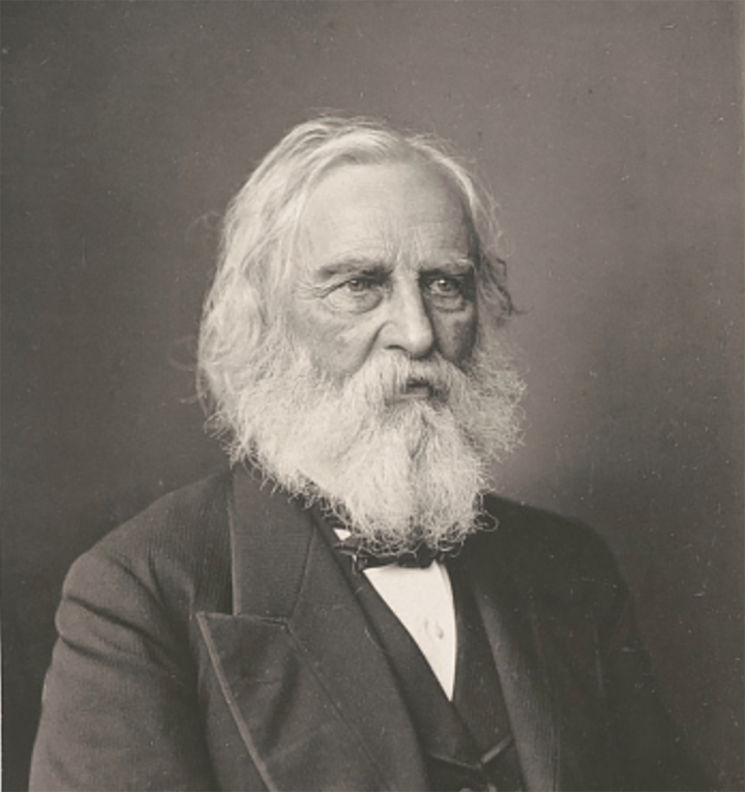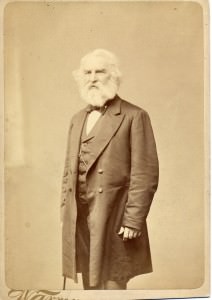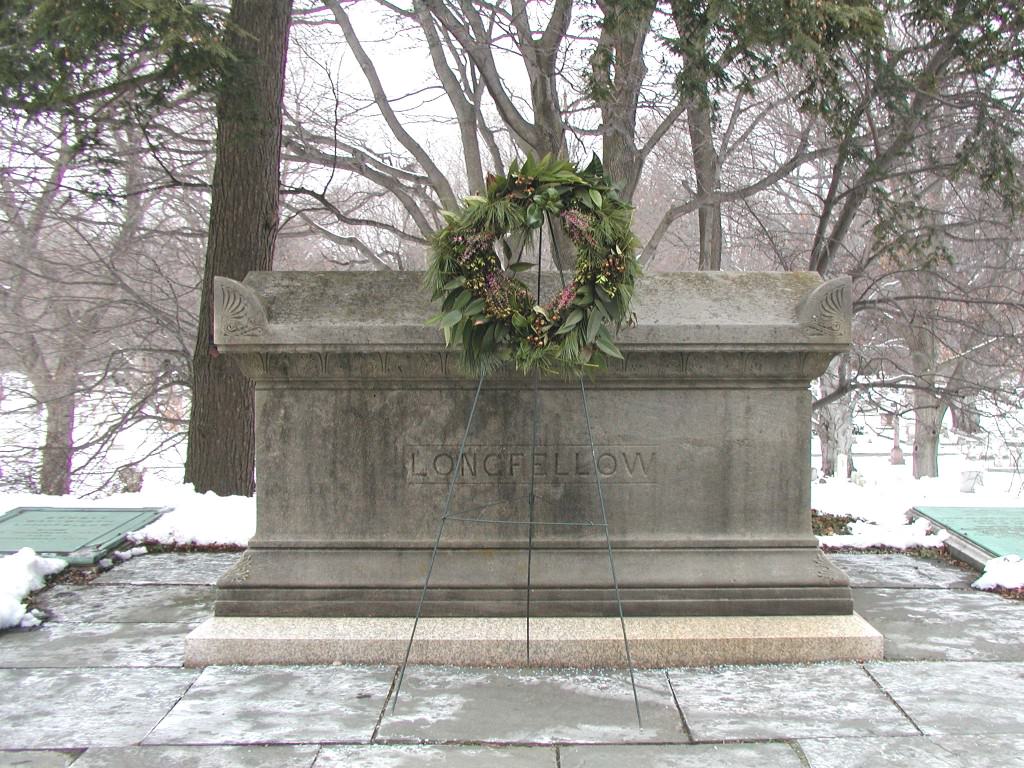Henry Wadsworth Longfellow (1807-1882)

Every year, as the anniversary of Henry Wadsworth Longfellow’s birthday approaches, it is inspiring to look back upon his life and legacy. Born on February 27,1807 in Portland, Maine, he was the second of eight children. He enrolled in Bowdoin College at the age of 15. When he graduated in 1825 he was ranked fourth in his class and was a member of Phi Beta Kappa. By this point, he had already written and published dozens of poems and knew that his life’s passion would be literature. Despite being offered a professorship at Bowdoin after graduating, Longfellow declined it and instead spent three years abroad in Europe, returning to America with a renewed dedication to writing.
This renewed dedication inspired him to eventually write some of America’s best known and beloved poetry. By the time he took up a teaching post at Harvard College in 1835, Longfellow had traveled extensively throughout Europe and Scandinavia, mastering over nine languages. Longfellow’s reputation as a writer was already firmly established when he resigned his post at Harvard in 1854 in order to devote his life to poetry. After his resignation, he wrote some of his most popular works such as The Song of Hiawatha in 1855 and Paul Revere’s Ride in 1860. In 1864, he also became the first American to begin translating Dante Alighieri’s Divine Comedy. This became his most ambitious works as the translation of Dante’s Divine Comedy in unrhymed verse.
Though Longfellow was an incredibly private man, he was a fiercely loyal friend and sought companionship from others who could help to inspire both his life and work. In 1836 he became a professor at Harvard. Here, as a young man, he forged intimate friendships as a member of the Five of Clubs. The Five of Clubs is also where he began his lifelong friendship with Senator Charles Sumner. Later in life he was also a part of the Dante Club where again he was surrounded by, amongst others, his friends James Russell Lowell and Oliver Wendell Holmes. The friends he made in these groups also shaped many of his views on current social and literary movements. Most importantly, his public condemnation of slavery and his unwavering, though at times strained, support for Charles Sumner and his cause.
While his life was very much so dedicated to his craft, Longfellow was also a devoted family man and romantic. His first wife, Mary Storer Potter, died four years into their marriage after suffering a miscarriage. Her death deeply affected him, causing him to write some of the few poems that can be directly linked to his personal thoughts or emotions. Eventually recovering, he embarked on a seven year courtship with Frances ‘Fanny’ Appleton and in 1843 they eventually married and had six children together. In 1860 a tragic accident occurred which left Fanny badly burned from a fire; she died the next morning unable to recover from her injuries. Longfellow, in his attempts to save her was badly burned himself. He would never fully recover from the devastation of losing Fanny. In 1879, 18th anniversary of Fanny’s death, he wrote another rare poem expressing his personal grief called The Cross of Snow.

Longfellow died at home on March 24, 1882 after going to bed with severe stomach pain. He was buried with both of his wives at Mount Auburn Cemetery. According to newspaper accounts, hundreds gathered for Longfellow’s funeral including Oliver Wendell Holmes and Ralph Waldo Emerson. Illustrations from Harper’s Weekly show the graveside scene and the funeral procession as it entered the gates of Mount Auburn Cemetery and moved up Central Avenue towards the family tomb on Indian Ridge Path. The casket was decorated with two palm branches and a spray of passion flowers, the symbolism of which Samuel Longfellow, the poet’s brother, noted in a letter afterwards: “He had known both the suffering and the victory.”
Longfellow’s monument was designed by his nephew, William Pitt Preble Longfellow, an architect and author. It is fashioned of Indiana limestone. On the left side of the monument is a Latin symbol with an inscription (pictured left) dating back to the 11th century at the church of St. Etienne at Caen, France. The Latin words Dux, Lex, Lux and Rex mean Leader, Law, Light and King. Longfellow used variations of this symbol for the title pages on two of his books and in the design for his garden in 1845.
Longfellow was the most popular poet of his time and today is thought of as one of the most important and distinguished poets that America has ever produced by playing a vital role in familiarizing Americans with European legend and literature. He maintained, however, a lifelong commitment to promoting American poetry as worthy of the recognition European poetry enjoyed, and helped lay the foundations for a native literature by giving form to American legends. The increasing monetary returns for his poetry reflects his popularity as America’s favorite household poet –from $15 for “The Village Blacksmith,” in 1840 to $3,000 for “The Hanging of the Crane” in 1874. During his lifetime, 10,000 copies of the Courtship of Miles Standish were sold in London in a single day. Though his popularity has declined, the importance of his work and his lasting impact on American culture is still seen today when, for instance, a child learns of how Paul Revere came to the rescue during his midnight ride by reading Longfellow’s portrayal of events.
Longfellow’s memorial can be found at Lot#580, Indian Ridge Path.
Before the great poet himself came to be buried at Mount Auburn in 1882, he experienced the deaths of several close family and friends. Here are a few poems that Longfellow wrote in memory of friends and family who are also buried at Mount Auburn.
Longfellow’s Children
All six of Longfellow’s children are buried at Mount Auburn. Four of the children are in the family lot, while two of Longfellow’s daughters are buried in their husband’s lots. Five of his six children survived into adulthood.
“Grave Alice, and Laughing Allegra, and Edith with the golden hair”
-The Children’s Hour
Lot #580, Indian Ridge Path
Charles A. Longfellow (1844 – 1893)
Ernest W. Longfellow (1845 – 1921)
Fanny Longfellow (infant) (1847 – 1848)
Alice M. Longfellow (1850 – 1928)
Lot #6209, Willow Avenue West
Annie Longfellow Thorp (1855 – 1934)
Lot #4863, Jonquil Path
Edith Allegra Longfellow Dana (1853 – 1915)
SOURCES
Portrait of Henry Wadsworth Longfellow (top image): Gutekunst, Frederick, photographer. Henry W. Longfellow / phototype, F. Gutekunst, Philada. , 1876. [Philadelphia: F. Gutekunst, ?] Photograph. https://www.loc.gov/item/2015651534/.

Leave a Reply